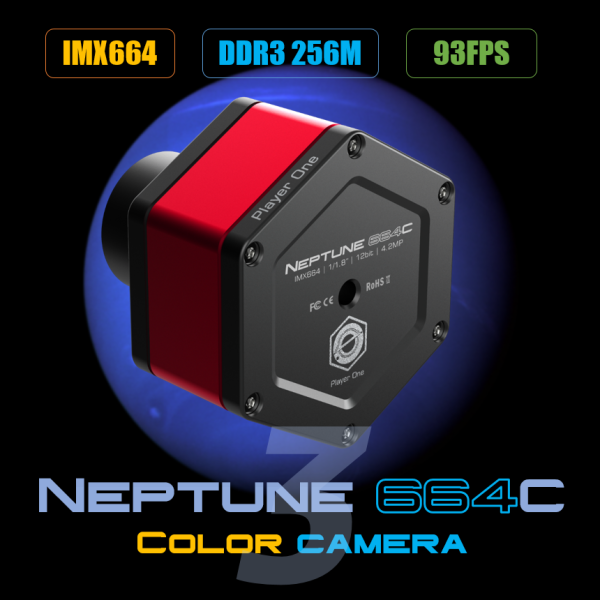Player One Astronomy NEPTUNE 664C USB3.0 Color Camera
Player One Astronomy NEPTUNE 664C USB3.0 Color Camera

Product Description
NEPTUNE 664C opened NEPTUNE 3rd Gen gate, the newest planetary camera which developed by Player One Astronomy. A successor of Neptune-C II (IMX464) camera. NEPTUNE 664C camera adopts the Sony IMX664 1/1.8” color sensor. The 2.9um pixel size accommodates a well depth of 38.5ke with a total of 4.2MP (the resolution is 2704*1540), and the diagonal is 6.46 mm.

Super AR Plus window
NEPTUNE 664C using this Super AR Plus window in front of it. This window glass can give super high transmittance from 310nm to 1100nm. This important improvement, make NEPTUNE 664C camera has much better performance in both Ultravoilet and NIR.

The naming of Player One Astronomy cameras is unique. For example, we name the planetary cameras after planets (They are Mercury, Venus, Mars, Jupiter, Saturn, Uranus, and Neptune, Earth is not included). The size of each planet to a certain extent represents the size of camera sensors. We will name Saturn with a 1-inch sensor camera, and for Mars, we will name it with a ½.8 inch sensor camera. All names will be engraved on the housing of the cameras.
STARVIS 2 Technology
NEPTUNE 664C based on Sony newest STARVIS 2 technology, it is back-illuminated pixel technology used in CMOS image sensors.

Non-Amp-Glow
Biggest supprise of NEPTUNE 664C camera is, its dark frame is totally “dark”, whatever we strength the curve, there is no AMP glow at all!
60s dark frame of NEPTUNE 664C camera(resize to 50%):

Features:

Comparison of 3 generations
Player One add all our best technology into 3rd Gen NEPTUNE 664C. You will see the advantages, like Super AR plus window, Passive cooling system. Those features will make sure NEPTUNE 664C to be very competitive on the market!

2nd Gen – Sensor Tilt Plate
The built-in high-density sponge shading pad can block the light from the side slits without any side leakage.

When taking solar photograph with prominence telescope, the Newton ring is annoying. Smoother solar image without Newton ring could be taken by adjusting the focal plate. Get a much smaller field curvature of the telescope.


256M DDR3 Cache
Player One Astronomy cameras are the first ones who adopt the DDR3 cache in all planetary cameras in the world! It helps stabilize and secure data transmission, effectively avoids frame dropping, and greatly reduces read noise.

With the DDR3 cache, the camera does not have high demands on computing needs any longer, it will still have excellent performance even if it is connected to a USB 2.0 port.
DPS technology
The planetary cameras from Player One Astronomy have DPS (Dead Pixel Suppression) technology. The DPS is anaylse many dark frames to find out thoes fixed abnormal pixel and record the map in camera memory. In imaging, each exposure frames, thoes position of dead pixels will be given a median value according to the active pixels around that abnormal pixel.




HCG Mode
NEPTUNE 664C camera has a unique HCG mode, which will automatically turn on when the camera gain setting is ≥180. The HCG mode can greatly reduce the readout noise and retain the same high dynamic range as the low gain.
QE Curve
The QE curve of the NEPTUNE 664C camera tell us that this camera is NIR enhanced camera. working after Super AR Plus window, this camera will keep very high QE in infrared.
This is the relative QE curve which provided by Sony, the absolute QE peak about 91%.



| Product Status | New |
|---|---|
| Package width | 8 cm |
| Package height | 9 cm |
| Package depth | 20 cm |
| No. of parcels | 1 |





